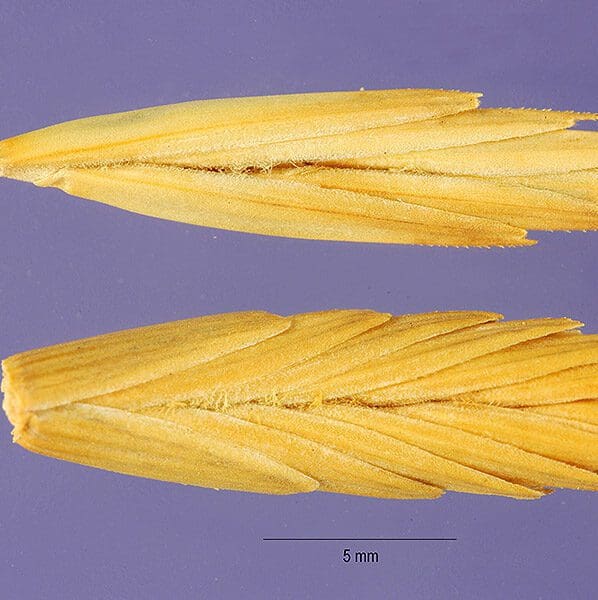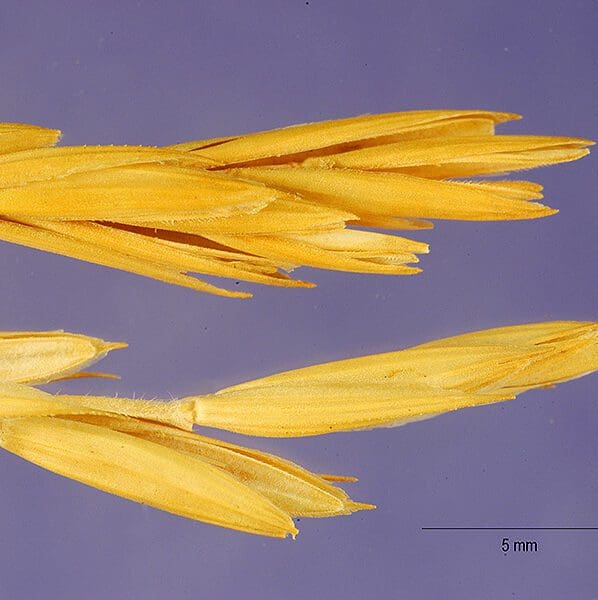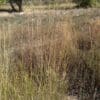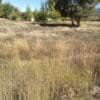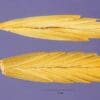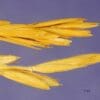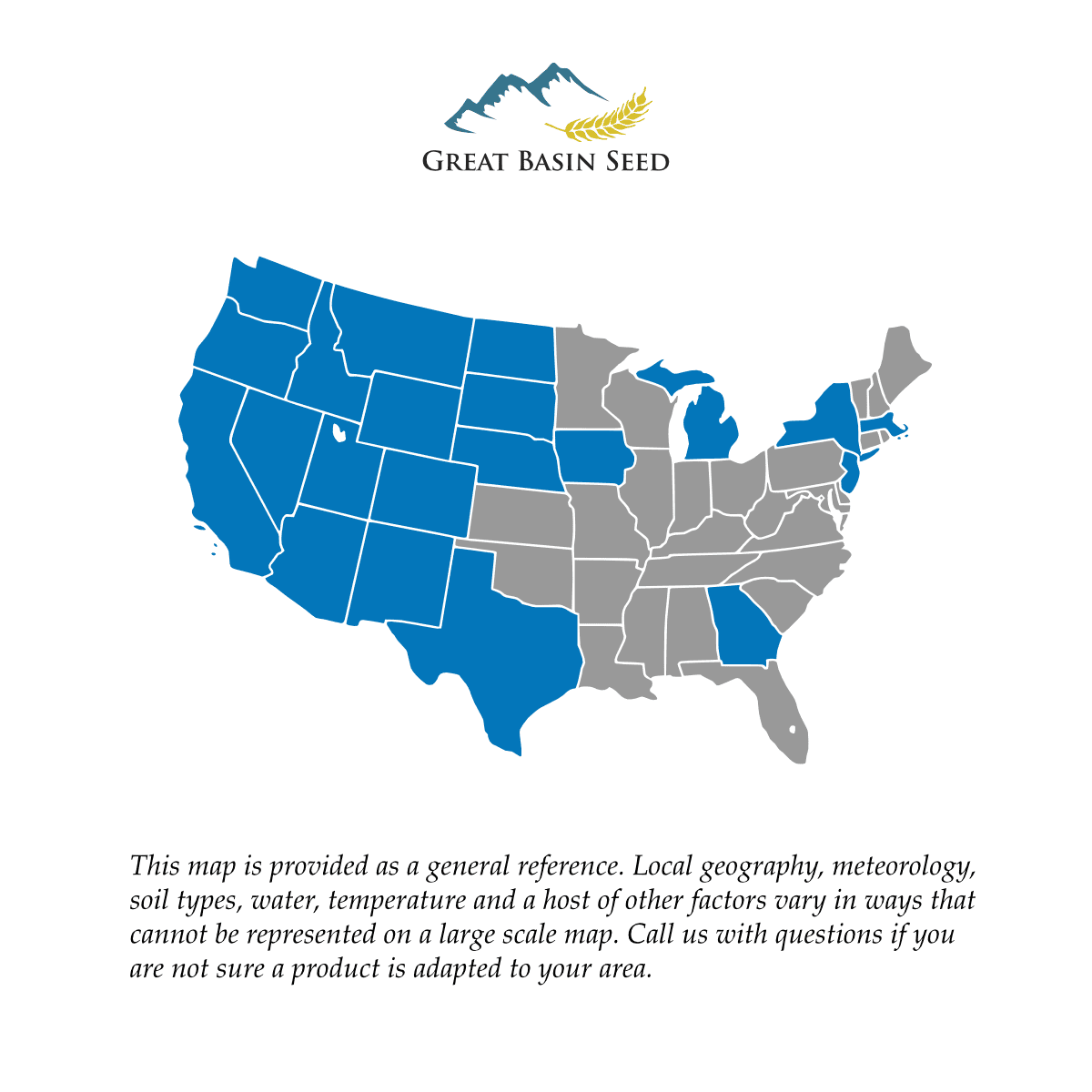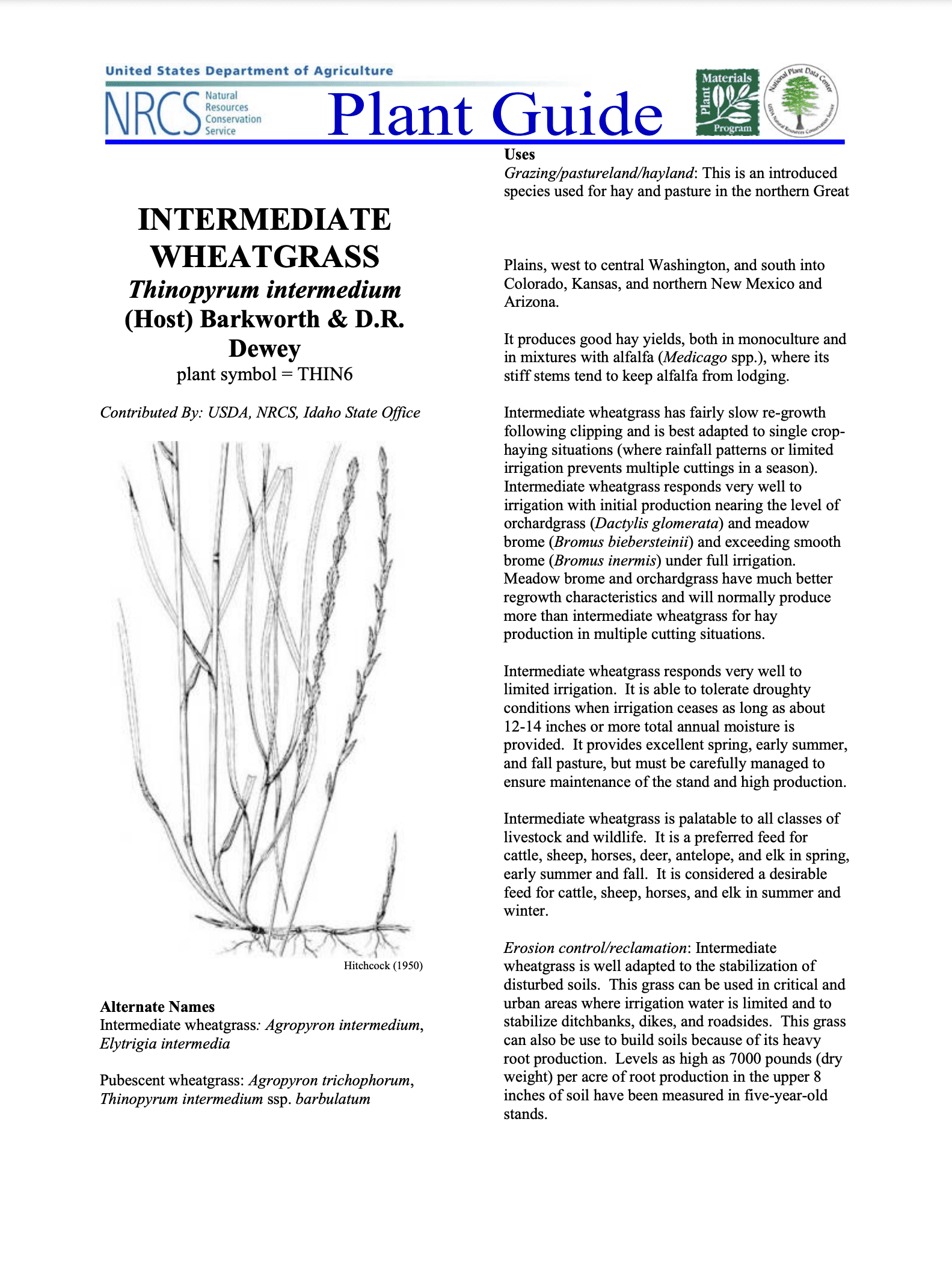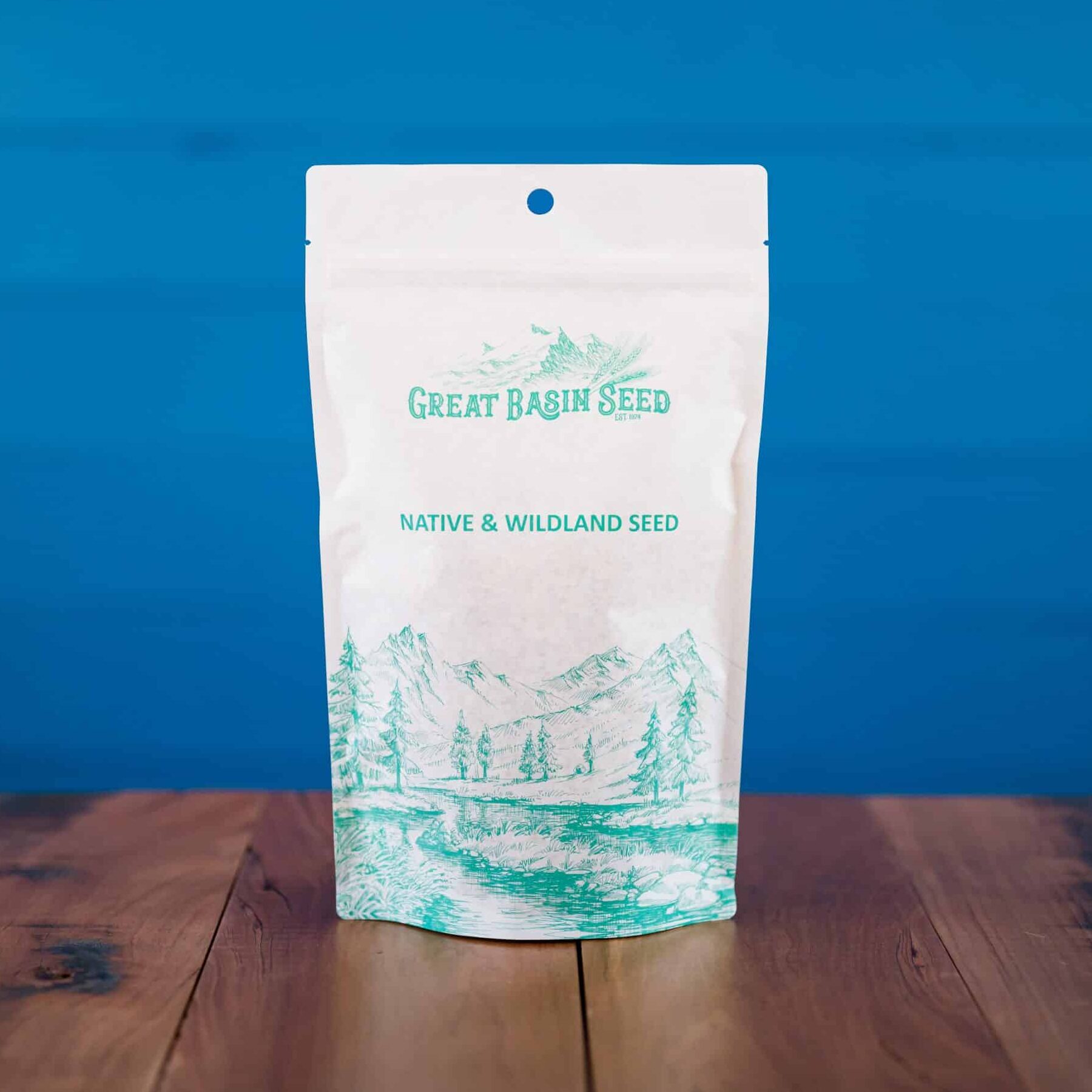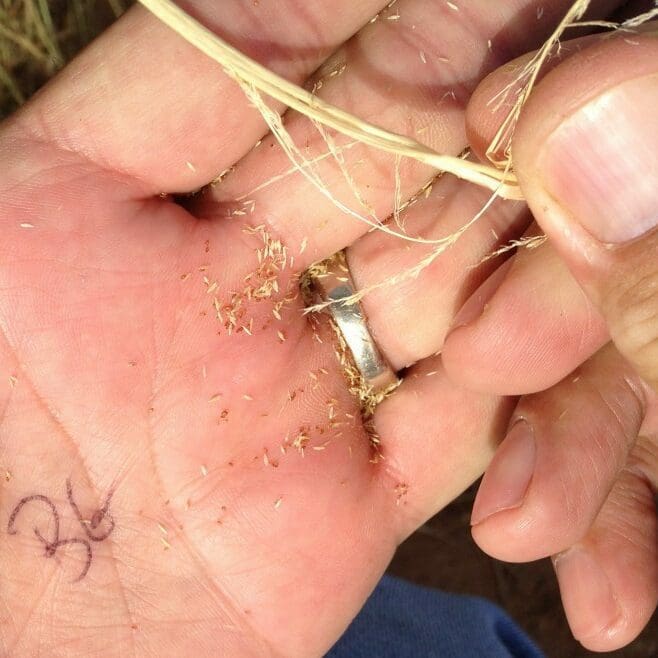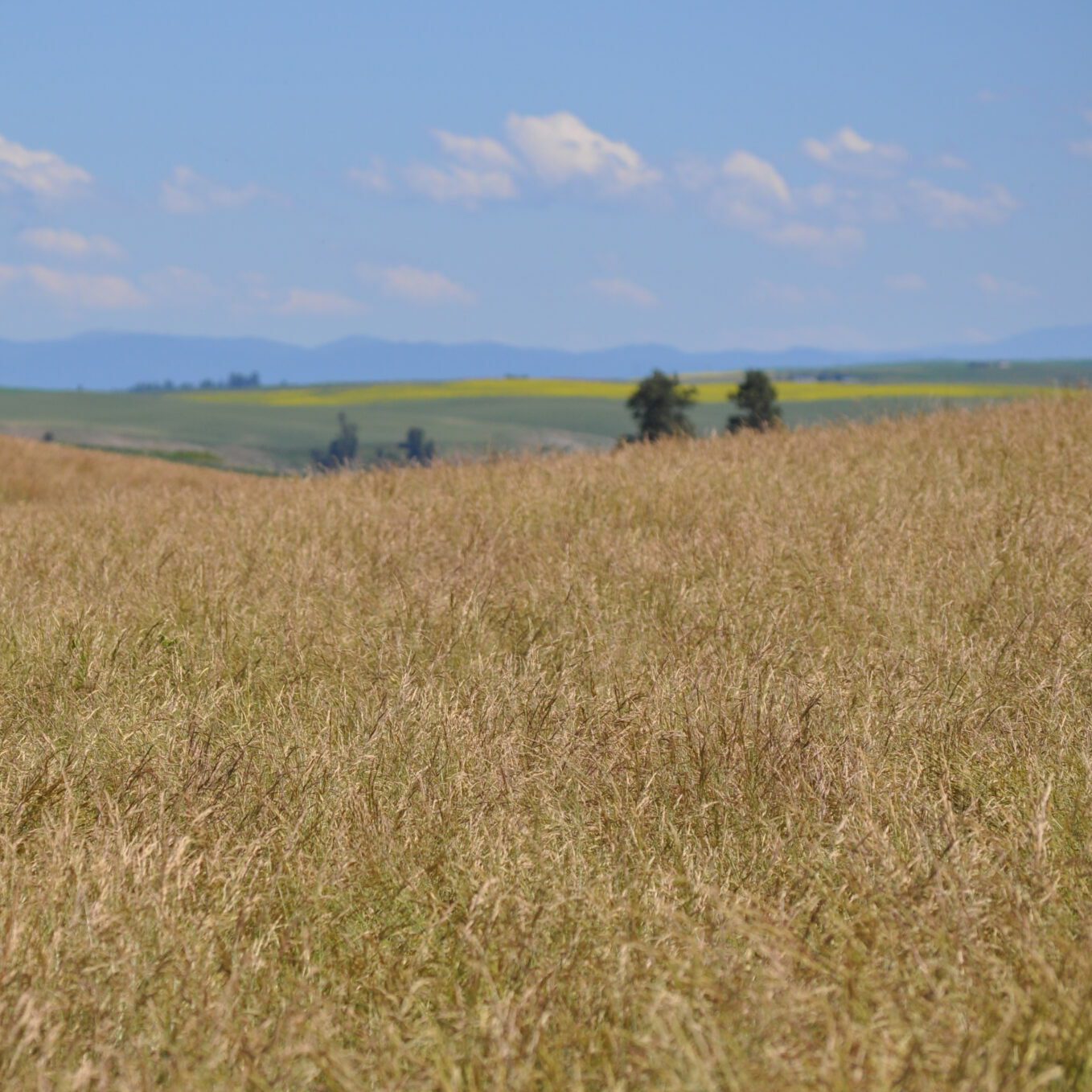Oahe Intermediate Wheatgrass
- Scientific name: Thinopyrum intermedium
- Widely used for hay and pasture
- Produces good hay yields
- Productive in both monoculture and mixtures
- Responds very well to irrigation
- Excellent for erosion control
Min. to Max. Annual Precipitation
48in.
Average Max. Height
A perennial sod-forming grass widely used for hay, forage and pasture across the United States. It is widely distributed, a favorite in pasture mixes. It produces good hay yields and grows to 3 to 4 feet tall. It is a long-lived with a deep root system.
Oahe Intermediate wheatgrass (Thinopyrum intermedium) is a perennial grass introduced in 1932 from Europe and Asia. It is widely used for hay, forage and pasture in the western United States. It is widely distributed and a favorite in pasture mixes. It produces good hay yields, both in monoculture and in mixtures. Intermediate wheatgrass grows to 3 to 4 feet tall. It is a long-lived, cool season sod-forming grass with short rhizomes and a deep feeding root system.
Intermediate wheatgrass (Thinopyrum intermedium) is adapted to areas with 12 to 14 inches of annual rainfall or greater. The pubescent form can tolerate slightly more droughty conditions to 11 or 12 inches of rainfall. It performs best between 3,500 and 9,000 feet elevation. It can be seeded at lower elevations, but moisture requirements are greater. It is commonly used as a drought tolerant species but is not as drought tolerant as Crested Wheatgrass, Siberian Wheatgrass or Russian Wildrye. It is cold hardy and not as susceptible to spring and fall freezing as Smooth Brome, Meadow Brome, or Orchardgrass.
Intermediate wheatgrass is palatable to all classes of livestock and wildlife in spring, early summer and fall. It is a preferred feed for cattle, sheep, horses, deer, antelope, and elk. It is considered a desirable feed for cattle, sheep, horses, and elk in winter. Livestock and wildlife will graze it throughout the growing season, but it is most preferred as forage in spring, early summer, and fall. A healthy, productive stand will not withstand heavy continuous grazing. Intermediate Wheatgrass provides excellent spring, early summer, and fall pasture, but must be carefully managed to ensure maintenance of the stand and high production.
Intermediate wheatgrass is well adapted to the stabilization of disturbed soils. This grass can be used in critical and urban areas where irrigation water is limited and to stabilize ditch banks, dikes, and roadsides. This grass can also be used to build soils because of its heavy root production. Under favorable conditions intermediate wheatgrass provides good weed suppression.
Eight inches of new growth should be attained in spring before grazing is allowed on established stands. A four-inch stubble height should be maintained following grazing or mowing and going into winter. In pasture tests, stands consistently out- yield other grass-legume mixtures. For this reason, stocking rates can be set higher than other grasses. Care should be taken to allow proper rest of at least 21 to 28 days between grazing periods under irrigated and high moisture situations.
Intermediate wheatgrass has fairly slow re-growth following clipping and is best adapted to single crop- haying conditions. It responds very well to irrigation with initial production nearing the level of orchardgrass and meadow brome and exceeding smooth brome under full irrigation.
Intermediate wheatgrass (Thinopyrum intermedium) establishes fairly quickly. Seedling vigor is good to excellent. Light, frequent irrigation is beneficial for stand establishment.
For farm, pasture and hay the recommended seeding rate is 15 lbs per acre drilled, 20 pounds per acre broadcast. For mine lands, roadsides, and other harsh critical areas, the seeding rate should be increased to 20- 25 pounds PLS per acre or 40- 50 PLS seeds per square foot.
‘Oahe’ intermediate wheatgrass was selected from seed originating in Russia by South Dakota AES, Brookings, South Dakota and was released in 1961. Named after the Oahe Dam on the Missouri River, it is an abbreviation for the Sioux word meaning “Big House.” It was selected for its uniformly bluish- green color, drought tolerance, vigor, rhizomatous traits and high seed yields. Oahe is adapted for hay, pasture and conservation purposes. Certified seed is available and South Dakota State University maintains Breeder seed.
‘Rush’ intermediate wheatgrass was selected from seed originating from sources in Germany. It was selected by the Aberdeen PMC and released by the Idaho AES and Aberdeen PMC in 1994. It was selected for superior seedling emergence and vigor compared to other intermediate wheatgrasses, good spring recovery, good rate of spread by rhizomes, uniform seedheads, wide leaves, high forage production, and high seed production. It has the largest seed of intermediate wheatgrasses, averaging 66,000 seeds per pound. It is adapted for soil erosion control, roadside stabilization, mine spoil stabilization, hayland, and pastureland both dry and irrigated, and forage for livestock and wildlife. It is not adapted to hay mixtures with alfalfa. Certified seed is available and Breeder seed is maintained by Aberdeen PMC.
Intermediate Wheatgrass Synonyms: Agropyron intermedium, Elytrigia intermedia Intermediate wheatrgass is closely related to Pubescent Wheatgrass (Agropyron trichophorum).
Oahe Intermediate Wheatgrass (South Dakota State University)
Oahe Intermediate Wheatgrass (South Dakota State University)
PDF version of South Dakota State University;
Open PRAIRIE: Open Public Research Access Institutional Repository and Information Exchange.
Citation: Ross, J. G. and Bullis, S. S., "Oahe Intermediate Wheatgrass" (1962). Bulletins. Paper 506.
Intermediate Wheatgrass NRCS Plant Guide
Intermediate Wheatgrass NRCS Plant Guide
PDF version of NRCS Plant Guide & Fact Sheet
Prepared By: Daniel G. Ogle, Plant Materials Specialist USDA, NRCS, Idaho State Office, Boise, Idaho
Loren St. John, Manager USDA, NRCS, Plant Materials Center, Aberdeen, Idaho
Dr. Kevin B. Jensen, USDA-ARS, Forage and Range Research Laboratory, Utah State University, Logan, Utah
Species Coordinator: Daniel G. Ogle USDA, NRCS, Idaho State Office, Boise, Idaho.
Helpful Links
Additional information about this product can be found on the academic websites linked below.
Synonyms
Many plants have more than one common and scientific name. We've listed a few of them below.
- Oahe Intermediate Wheatgrass
- Thinopyrum intermedium
- Agropyron intermedium
- Elytrigia intermedia Intermediate
Who is Great Basin Seed?
Great Basin Seed is a seed company that specializes in seed sales and consultation for home, ranch, farm, range and reclamation. We have been a leader in the seed industry since 1974.
Our History
We've been in the seed business since 1974.
What We Offer
We offer seed for home, farm, ranch, range and reclamation projects.
Meet the Gang
We have the best employees in the world! We are proud of the work they do, and trust them to serve you!
Right: Company founder Lloyd and his wife Paula Stevens in a wildflower seed production field circa 1977
Quick Plant Facts
| Common Name: | Intermediate Wheatgrass |
|---|---|
| Scientific Name: | |
| Old Scientific Name: | |
| Plant Type: | |
| Origin: | |
| Lifespan: | |
| Planting Rate: | |
| Max Sowing Depth: | |
| Available Varieties: | |
| Seed Count | 88,000 seeds/lb. |
| Growth Season: | |
| Min. Precipitation | 12-14 inches |
| Growth Height: | |
| Root Form | Sodformer |
| Sun & Shade Tolerance: | Full Sun, Shade Intolerant |
| Elevation of Occurance: | |
| pH Tolerance: | |
| Best Time to Sow: | |
| Hardiness Zones: |


